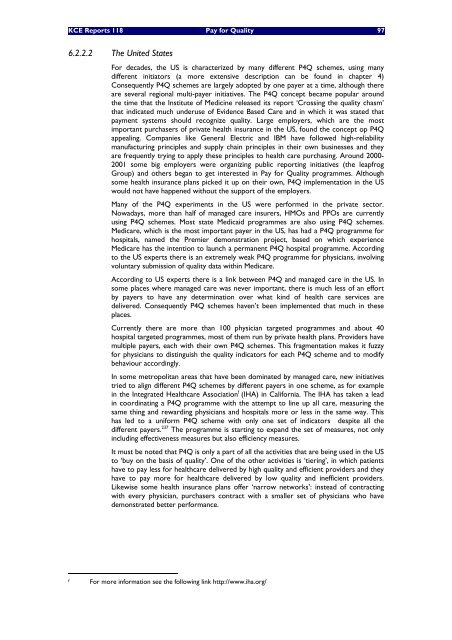Pay for Quality
Pay for Quality
Pay for Quality
Create successful ePaper yourself
Turn your PDF publications into a flip-book with our unique Google optimized e-Paper software.
KCE Reports 118 <strong>Pay</strong> <strong>for</strong> <strong>Quality</strong> 97<br />
6.2.2.2 The United States<br />
For decades, the US is characterized by many different P4Q schemes, using many<br />
different initiators (a more extensive description can be found in chapter 4)<br />
Consequently P4Q schemes are largely adopted by one payer at a time, although there<br />
are several regional multi-payer initiatives. The P4Q concept became popular around<br />
the time that the Institute of Medicine released its report ‘Crossing the quality chasm’<br />
that indicated much underuse of Evidence Based Care and in which it was stated that<br />
payment systems should recognize quality. Large employers, which are the most<br />
important purchasers of private health insurance in the US, found the concept op P4Q<br />
appealing. Companies like General Electric and IBM have followed high-reliability<br />
manufacturing principles and supply chain principles in their own businesses and they<br />
are frequently trying to apply these principles to health care purchasing. Around 2000-<br />
2001 some big employers were organizing public reporting initiatives (the leapfrog<br />
Group) and others began to get interested in <strong>Pay</strong> <strong>for</strong> <strong>Quality</strong> programmes. Although<br />
some health insurance plans picked it up on their own, P4Q implementation in the US<br />
would not have happened without the support of the employers.<br />
Many of the P4Q experiments in the US were per<strong>for</strong>med in the private sector.<br />
Nowadays, more than half of managed care insurers, HMOs and PPOs are currently<br />
using P4Q schemes. Most state Medicaid programmes are also using P4Q schemes.<br />
Medicare, which is the most important payer in the US, has had a P4Q programme <strong>for</strong><br />
hospitals, named the Premier demonstration project, based on which experience<br />
Medicare has the intention to launch a permanent P4Q hospital programme. According<br />
to the US experts there is an extremely weak P4Q programme <strong>for</strong> physicians, involving<br />
voluntary submission of quality data within Medicare.<br />
According to US experts there is a link between P4Q and managed care in the US. In<br />
some places where managed care was never important, there is much less of an ef<strong>for</strong>t<br />
by payers to have any determination over what kind of health care services are<br />
delivered. Consequently P4Q schemes haven’t been implemented that much in these<br />
places.<br />
Currently there are more than 100 physician targeted programmes and about 40<br />
hospital targeted programmes, most of them run by private health plans. Providers have<br />
multiple payers, each with their own P4Q schemes. This fragmentation makes it fuzzy<br />
<strong>for</strong> physicians to distinguish the quality indicators <strong>for</strong> each P4Q scheme and to modify<br />
behaviour accordingly.<br />
In some metropolitan areas that have been dominated by managed care, new initiatives<br />
tried to align different P4Q schemes by different payers in one scheme, as <strong>for</strong> example<br />
in the Integrated Healthcare Association f (IHA) in Cali<strong>for</strong>nia. The IHA has taken a lead<br />
in coordinating a P4Q programme with the attempt to line up all care, measuring the<br />
same thing and rewarding physicians and hospitals more or less in the same way. This<br />
has led to a uni<strong>for</strong>m P4Q scheme with only one set of indicators despite all the<br />
different payers. 237 The programme is starting to expand the set of measures, not only<br />
including effectiveness measures but also efficiency measures.<br />
It must be noted that P4Q is only a part of all the activities that are being used in the US<br />
to ‘buy on the basis of quality’. One of the other activities is ‘tiering’, in which patients<br />
have to pay less <strong>for</strong> healthcare delivered by high quality and efficient providers and they<br />
have to pay more <strong>for</strong> healthcare delivered by low quality and inefficient providers.<br />
Likewise some health insurance plans offer ‘narrow networks’: instead of contracting<br />
with every physician, purchasers contract with a smaller set of physicians who have<br />
demonstrated better per<strong>for</strong>mance.<br />
f For more in<strong>for</strong>mation see the following link http://www.iha.org/
















